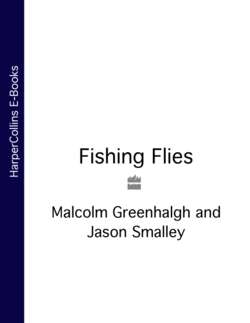Читать книгу Fishing Flies - Smalley - Страница 49
CASELESS CADDIS LARVAE
ОглавлениеDuring a flood, when boulders are being carried downstream, some caddis lose their cases as they are swept away. Autopsies suggest that trout look out for these caseless caddis and quickly mop them up. Fish as the river is fining down.
There are two main groups of caseless caddis larvae:
Rhyacophila is a group of free-living larvae that wander amongst the river-bed boulders and mosses seeking lesser creatures to devour. These may include other nymphs and larvae, fish eggs, and trout and salmon alevins.
Hydropsyche and their allies is a group of net-spinning larvae. They build tents and tubes from silk in which they take cover and which they also use to filter the water of food items. Trout are unlikely to encounter them in their hideaways – but they are very territorial, and as the Hydropsyche larvae grow, they each need more space and, as the stronger individuals retain territories, the weaker are forced to leave. Thus, throughout spring and summer, small numbers of larvae drift away downstream and may be eaten by trout.
WEIGHT: While some may be tied without ballast for shallower water, most should have a layer of fine lead wire wound in touching turns along the hook shank. Where the use of lead is prohibited, tungsten wire or foil, or copper wire might be used.
QUILL LARVA
Hook: Nymph or curved caddis hook, sizes 12–14.
Thread: As abdomen.
Abdomen: Ginger or green cock hackle stalk.
Thorax and legs: Brown ostrich herl, with the top fibres trimmed away. It is worth strengthening the top of the thorax with a good, slightly thickened head cement.
The ginger stalk version matches Hydropsyche, the green Rhycophila. This simple pattern is a modification of A. K. Best’s Caddis Quill Larva (in A. K.’s Fly Box, 1996).
BREAD CRUST
Hook: Nymph, sizes 10–14.
Thread: Black.
Body: Orange, cream or green floss
Rib: Dark brown hackle stalk.
Hackle: Grizzle hen.
A popular US pattern by Larry Solomon and Eric Leiser (in Caddis and the Angler, 1977), the latter two body colours seem more effective in Europe.
During the late 1940s and 1950s C. F. Walker made a special study of the trout insects in British lakes and rivers. The following fly is perhaps the earliest imitation of a Rhyacophila larva.
CASELESS CADDIS
Hook: Nymph, sizes 12–14.
Thread: Olive.
Body: Seal’s fur (or substitute), ½ olive, ½ green, well mixed.
Rib: Oval gold tinsel.
Hackle: Woodcock underwing covert.
Head: Cock pheasant tail herl.
FUR-BODIED RHYACOPHILA
Hook: Curved caddis hook, sizes 12–14.
Thread: Olive.
Abdomen: Green, olive green or light green fur (a mix of, for example, rabbit and seal’s fur is better than only one type).
Rib: Fine gold wire or finest oval tinsel.
Thorax: Hare’s ear.
Legs: Few fibres brown speckled partridge hackle (optional).
Essentially a lake pattern that is very effective in the evening – fished along shores onto which waves are breaking.
FUR-BODIED HYDROPSYCHE
Hook: Curved caddis hook, sizes 12–14.
Thread: Light brown.
Abdomen: Grey or light buff fur.
Rib: Fine gold wire.
Thorax: Hare’s ear.
Legs: Few fibres grey partridge hackle (optional).
These two flies are most effective in fairly shallow, turbulent, bouldery water where the trout are most likely to find washed-out or drifting natural larvae.
Gorjan Franko lives in Tolmin, a small town on the Soca River (Slovenia). The Soca is full of trout, grayling and Hydropsyche, and the three come together well with Gorjan’s imitation.
HYDROPSYCHE (GORJAN FRANKO)
Hook: Wet fly, sizes 10–12.
Thread: Brown.
Body: Mix of 1⁄3 brown and 2⁄3 cream fur (fine textured).
Rib: Fine gold wire.
Hackle: Brown speckled partridge.
Upstream of Tolmin there are some very rapid stretches of river. To fish there, tie some with a tungsten bead at the head to get the fly down to the fish!
The following is a slight modification of one of Roman Moser’s caddis larvae for the River Traun.
HYDROPSYCHE
Hook: Wet fly, sizes 10–12.
Thread: Brown.
Tails (to represent the short tassel-ended ‘prolegs’ at the end of the body): Few fibres grey partridge hackle, cut short.
Body: Light grey or buff wool.
Shellback: Brown raffine.
Rib: Thick brown thread.
Legs: Brown speckled partridge hackle fibres.
Head: Hare’s ear.
Gary LaFontaine wrote the important textbook, Caddis Flies (1981), in which he explored North American caddis species and their life cycles, and created some fine imitations. The following is a useful general pattern – change the abdomen colour to buff, grey, brown and olive to match other species.
BRIGHT GREEN FREE-LIVING CADDIS
Hook: Curved grub/shrimp, sizes 10–12.
Thread: Brown.
Underbody: Fine lead wire.
Abdomen: Mix of 50 per cent olive and 50 per cent bright green fur or wool.
Rib: Brown cock hackle stalk.
Thorax: Dark olive-brown fur.
Hackle: Speckled grouse hackle fibres.
The next two tyings are by Oliver Edwards, whose book FlyTyers’ Masterclass, videos/DVDs and tying demonstrations have inspired many around the world of fly-tying, from Japan, through Europe to the United States.
